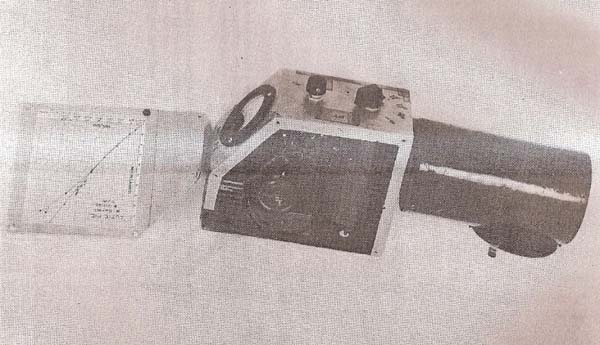
Clinton Laboratories (predecessor to the Oak Ridge National Laboratory)
The Clinton Laboratory was founded in 1943 near Clinton, Tennessee. It was originally operated by the University of Chicago and then by Monsanto Chemical Company in 1945. One of the early directors of the Health Physics Department was H. M. Parker who left in 1944 to head the instrument department at the Hanford Engineer Works in Hanford, Washington. The next director was Karl Z. Morgan. It was later renamed the Oak Ridge National Laboratory. The Oak Ridge National Laboratory published the Instrument Manual ORNL-332 beginning in 1949 by the Health Physic Division. The manual outlines the radiation monitoring equipment used at the laboratory and those instruments developed at the laboratory. Most instruments were developed by the laboratories during the war with only five industrial companies with contracts for instruments due to the secrecy of the project. The Manhattan District in 1946 established the Instrument Production Section of the Oak Ridge Research Division to help develop industrial production of instrument under government contracts. The Navy's Bureau of Ships and Manhattan District requirements were consolidated. In 1947, the Radiation Instruments Branch published the first issue of Ra-Det, a restricted monthly periodical with information on radiation detection instruments for government and laboratory agencies doing related work. The Radiation Instrument Catalog, in 1949, listed commercial instruments being used at the laboratories. A "Bibliography of Radiation Detection" was also issued that year. In 1948, the AEC prepared performance requirements for the various classes of radiation detection instruments as a guide to industries entering the field. In 1949, there were nine conferences on radiation detection instruments. By 1950, almost 80 commercial firms were manufacturing radiation instruments.
Mr. Ray developed the Paint Pail ion chamber at the Clinton Laboratory in 1944. The Zeus from the Chicago Met Lab later superseded it.
Due to the demand on production in this period, the labs contracted the Hallicrafters Company to manufacture a large number of beta-gamma detection instruments. The instruments covered the range of 0.001R/8-hr.
At Oak Ridge, the most useful instrument initially was the electroscope. It was simple to operate and held a calibration for several months. The two most widely used were the Lauritsen and the Landsverk-Wollan electroscopes in 1948.
Need photo
Oak Ridge Cutie Pie 1943
One of the first instruments was the Cutie Pie in 1944. C.O. Ballou and H.U Fisher developed the Cutie Pie in 1944 at the Clinton Laboratories. It was a portable beta-gamma radiation meter with exceedingly small dimensions and weight. The unit weighed 4 lbs. 2 oz and is carried in a pistol grip. Exclusive of the handle and chamber, the unit is 3 wide x 6.5 long x 5 high. The case was formed of aluminum. It has three ranges from 50, 500 and 5,000 mR/h.The chamber was 3.25 diameter x 6 long. It was named Cutie Pie due to its diminutive size.

Original Cutie Pie Ion Chamber 1944
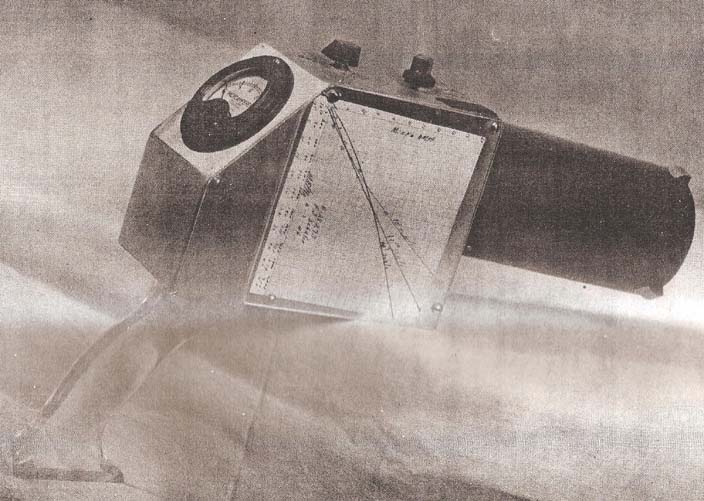
Clinton Laboratories Cutie Pie 1947
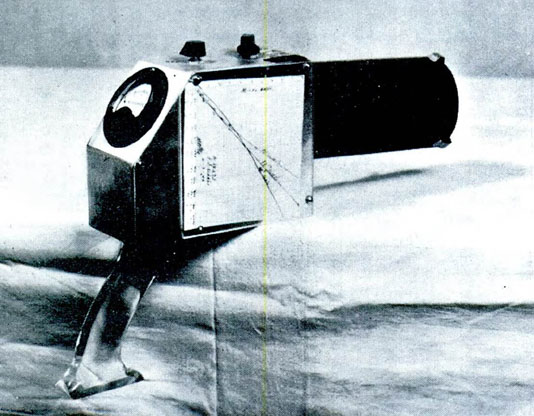
Cutie Pie for Monitoring External Radiation 1946
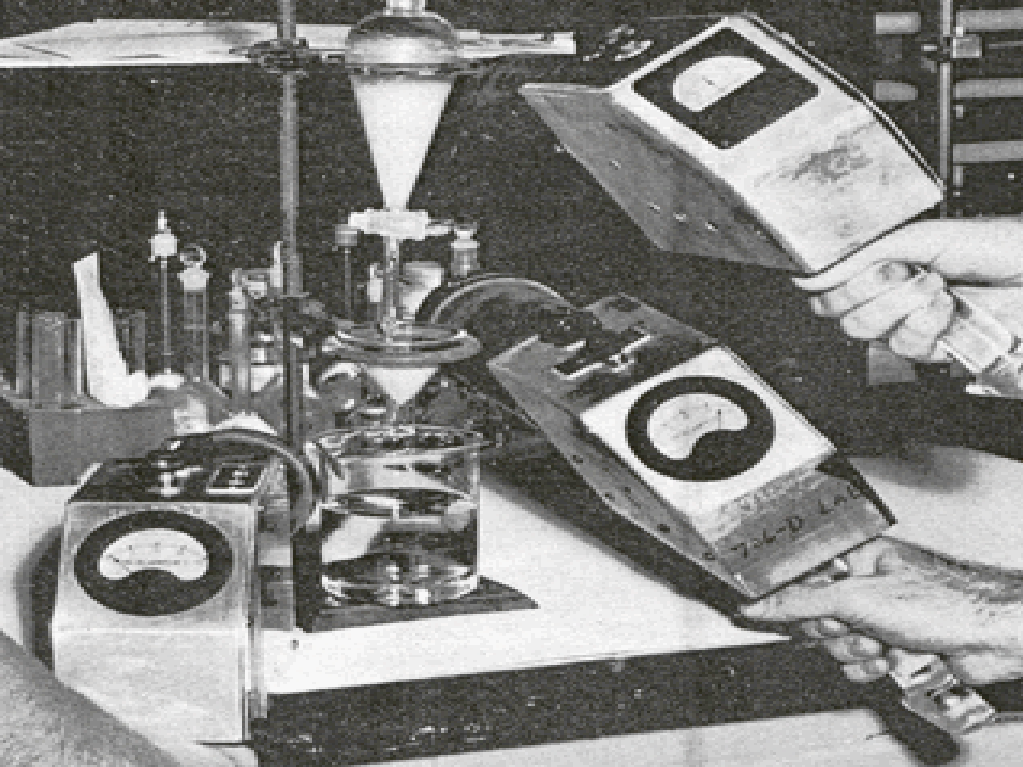
Clinton Laboratories Cutie Pies pre-1947
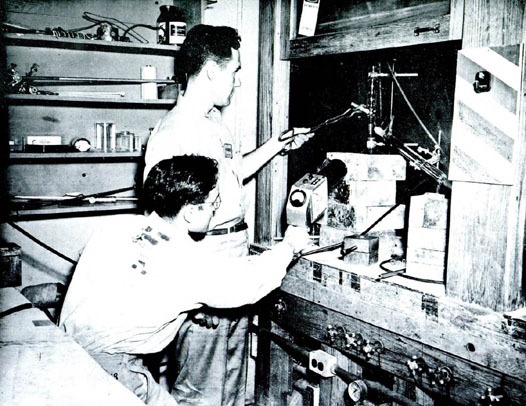
Clinton Laboratory Cutie Pie for Monitoring Iodine Extraction 1946
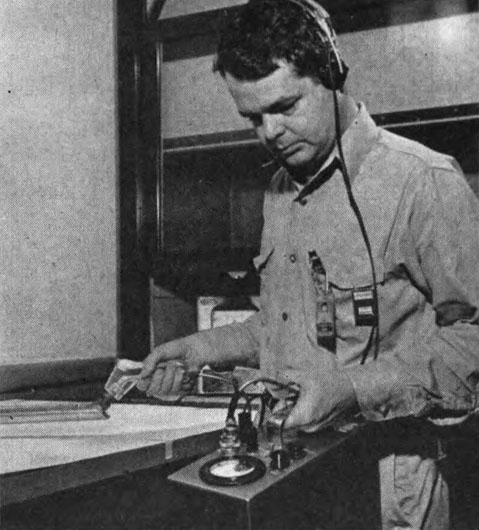
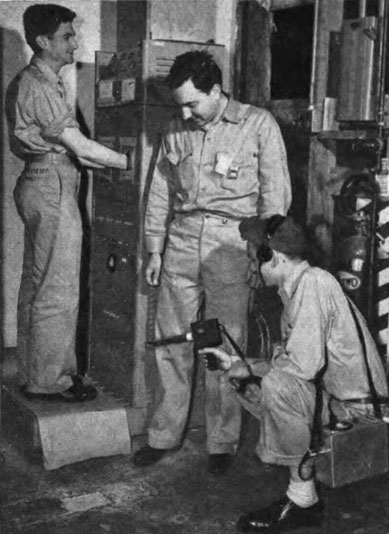
A Health Physicist surveys a desk with a Pee Wee for alpha contamination (left) and technician surveys for contamination using a Geiger Counter (right 1950
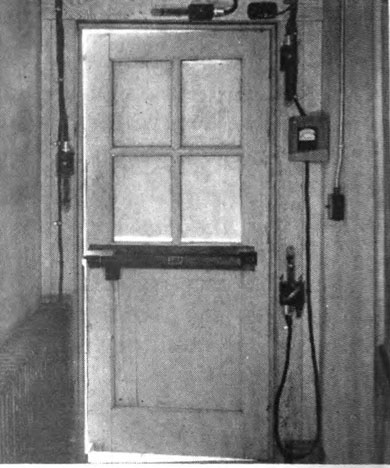
Geiger counter detectors called "Friskers" ring the doorway to monitor workers exiting the building, monitoring by meter and an alarm 1950
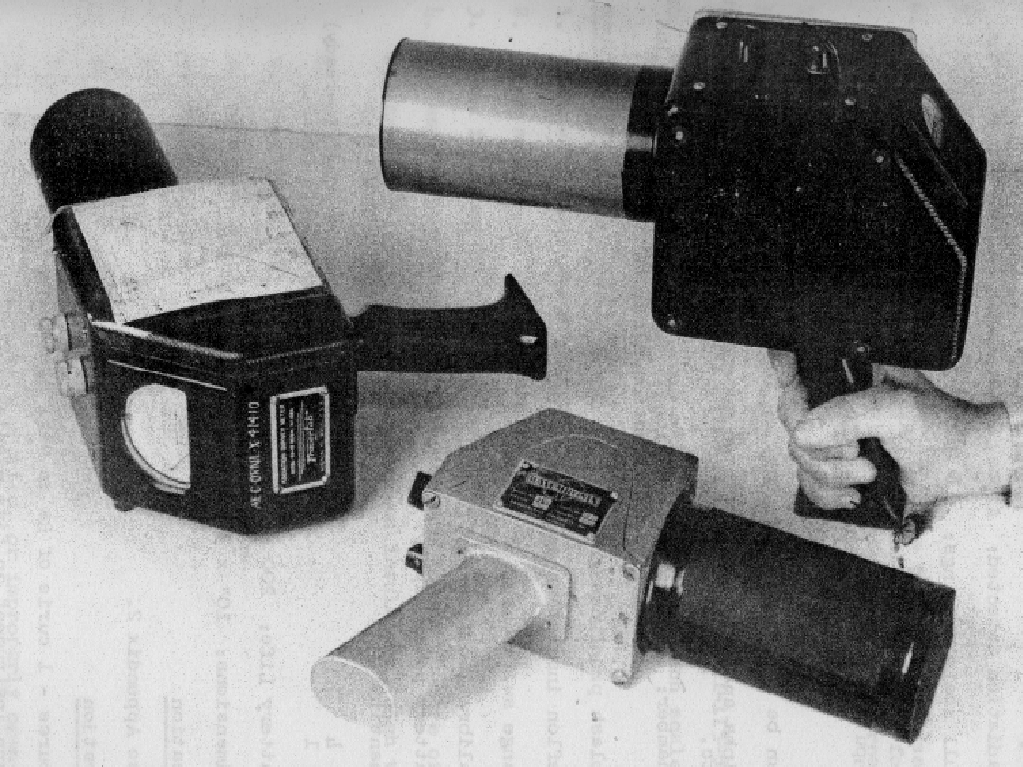
Cutie Pie Collection at Oak Ridge National Laboratory 1952
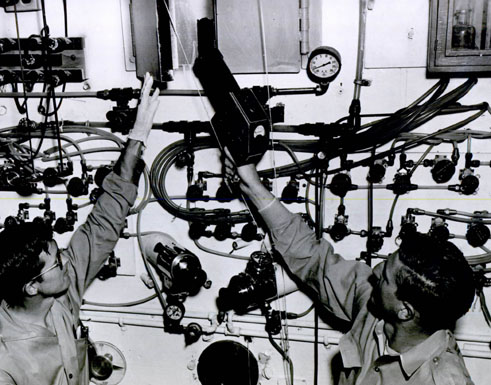
Cutie Pie used for Monitoring for Leaks 1946
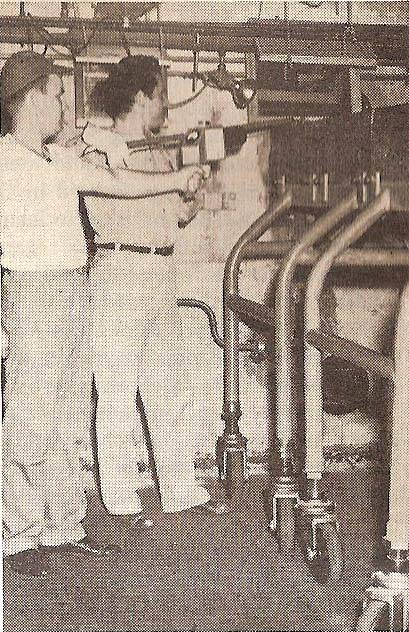
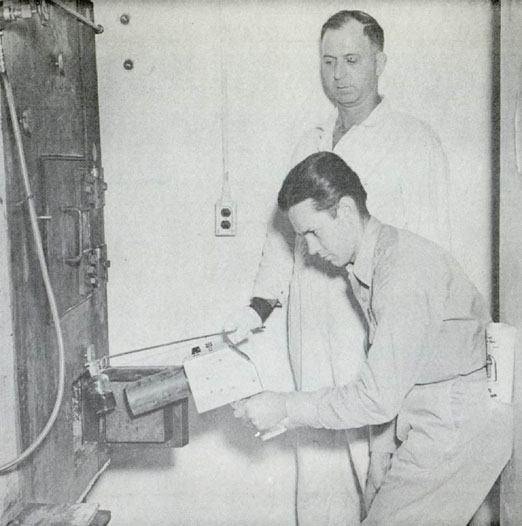
Fission product emitting high levels of radiation are processed inside thick-walled concrete cell at Oak Ridge National Laboratory. Workers monitoring dose rate through an opening using an Cutie Pie, 1950's
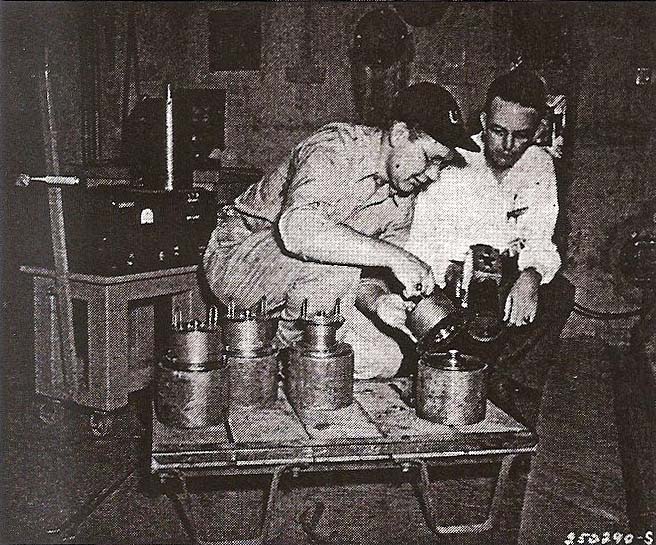
Workers used lead shields for high activity sample and monitor with a Cutie Pie 1950
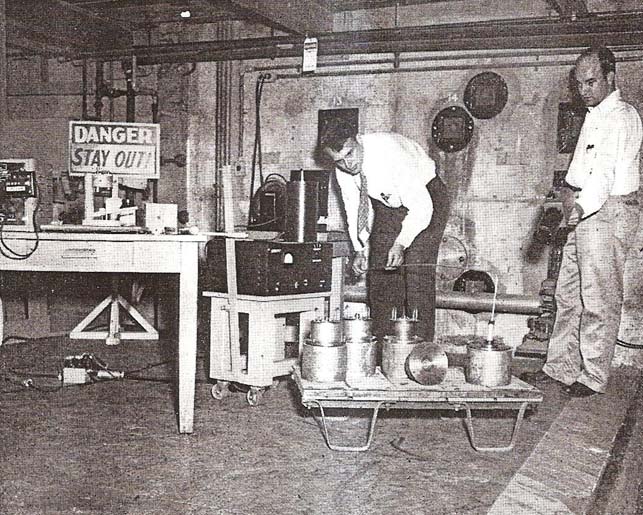
Workers check high activity samples in lead shields and monitor with a Cutie Pie 1950
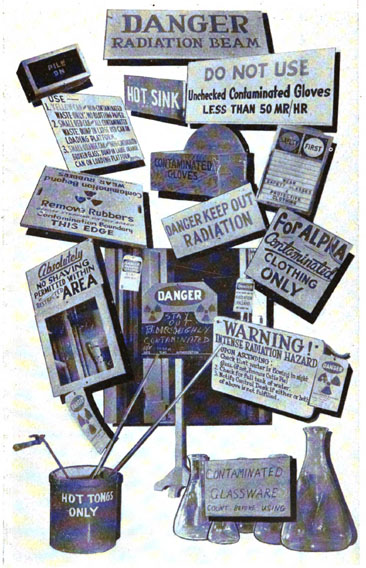
Radiation Warning Signs Collage 1950
The name has been the debate of many discussions, some indicated it referred to the charge collected on the chamber Q x t x pi (referring to change collected in a two pi chamber) or it could be just the early response when first observed that is a real cutie pie. The Cutie Pie was declassified in 1946. It had a hinged window on the front end of the chamber to allow changing absorbers and thereby measuring betas and gammas. It used seven small batteries and provide three ranges.
The Monitron I was developed in 1944 to aid in continuous area monitoring with the increasing severe health radiation hazards associated with the Manhattan project. The requirement was for eight units located at various points in the building. It had two ranges - 25 mR/h and 125 mR/h. Each unit will have a printer attached to record the two indictors. Each unit will have a distinct color. For the 25 mR/h range, an alarm would trip at 12.5 mR/h. The alarm would consist of a sound buzzer, a red signal lamp on the instrument panel and one light on the recorder panel. For the 125 mR/h range, three warning lamps will be turned on which will be yellow or amber. The lights will be on the instrument panel, a 100 watt lamp above the instrument and a light on the recorder panel. The Monitron was a desktop unit and AC powered.
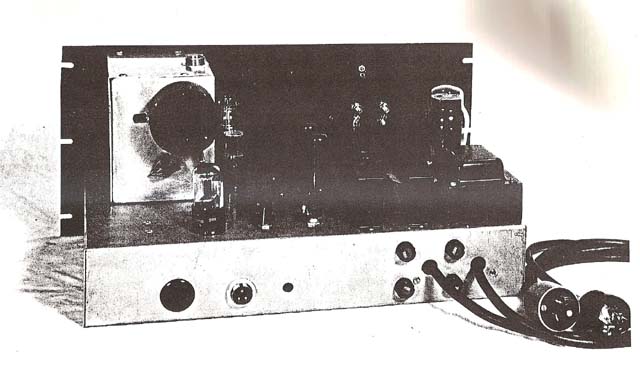
Clinton Labs Monitron I Air Monitoring System 1944
The GM Gun Model Q-821 was developed by D. J. Knowles in 1948 at the Clinton Laboratories. The unit has a self-contained battery providing 350 volts to the GM tube. The radiation detected was beta and gamma. The unit weighs 1.5 lbs. It had an earphone indicator. The GM tube was a Mark 1, Model 90 glass walled from Radiation Counter Laboratories. The GM Gun counter appears to be one of the original Cutie Pie models pre-dating 1948.
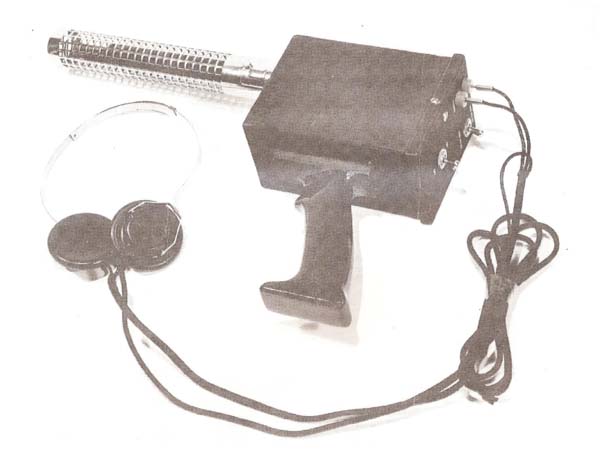
GM Gun Survey Probe Model Q-821 1948
It was designed to measure intense gamma fields produced by early reactors. Some versions employed two calibration sources 27 mg radium and 700 mCi cobalt-60. The instrument has an indicator in microamperes and a conversion chart to convert to mR/h for the different scale settings. It could measure between 5 mR/h and 10 R/h. The unit had ranges from 100, 1000 and 10,000 mR/h. Other chamber ranges were 30, 300 and 2,000 mR/h. The unit was 10 x 3 x 8. The chamber is 6 x 3. The standard Cutie Pie model weighed 2.75 lbs. It came in a bakelite shell.
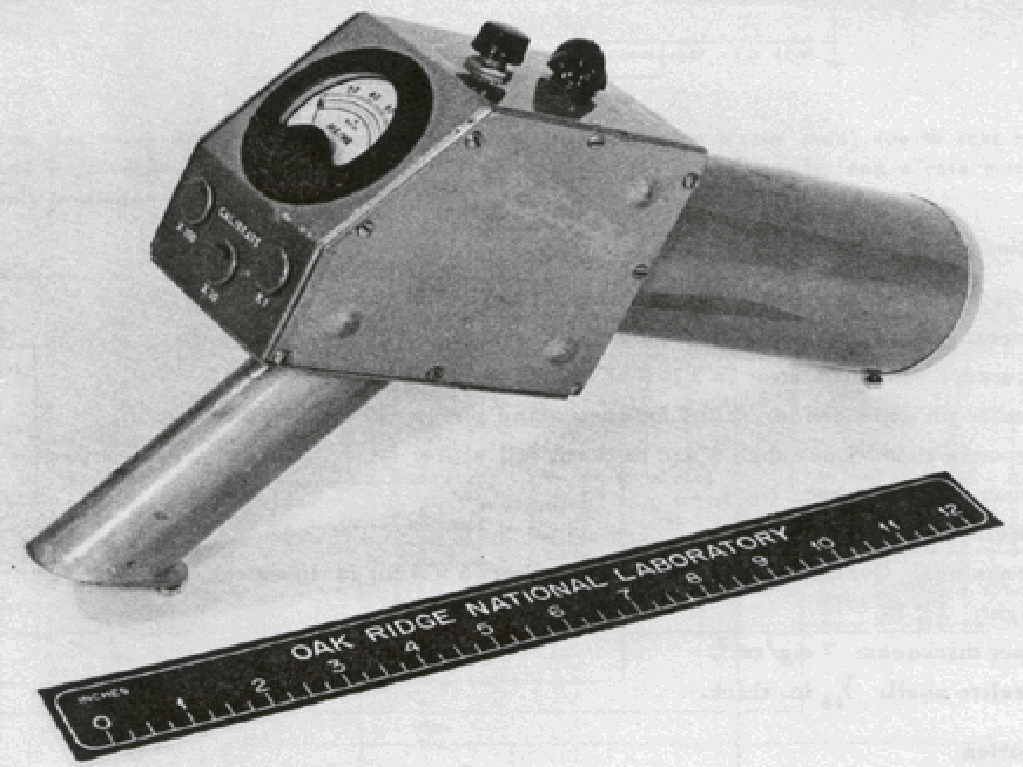
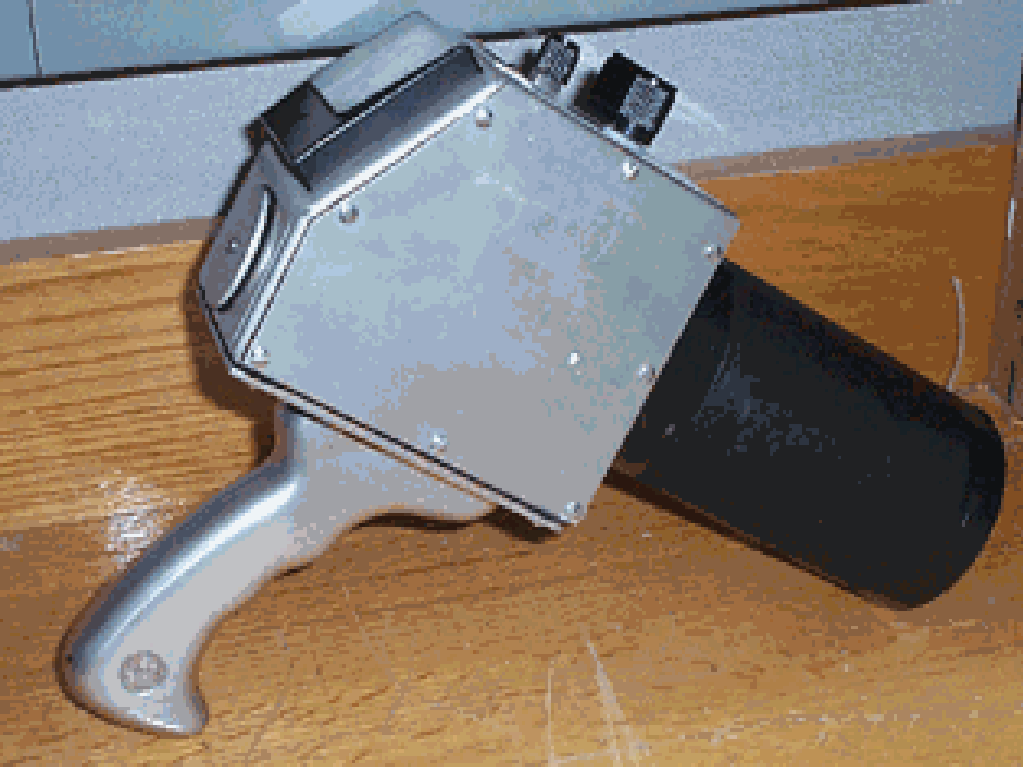
Oak Ridge Cutie Pie 1954
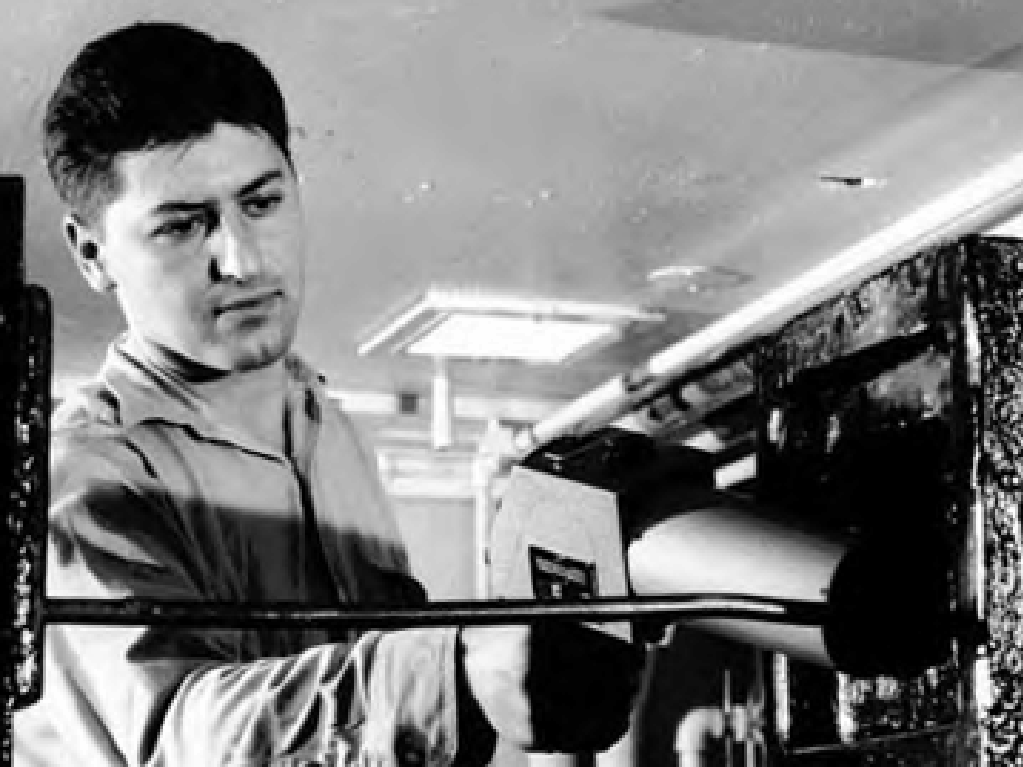
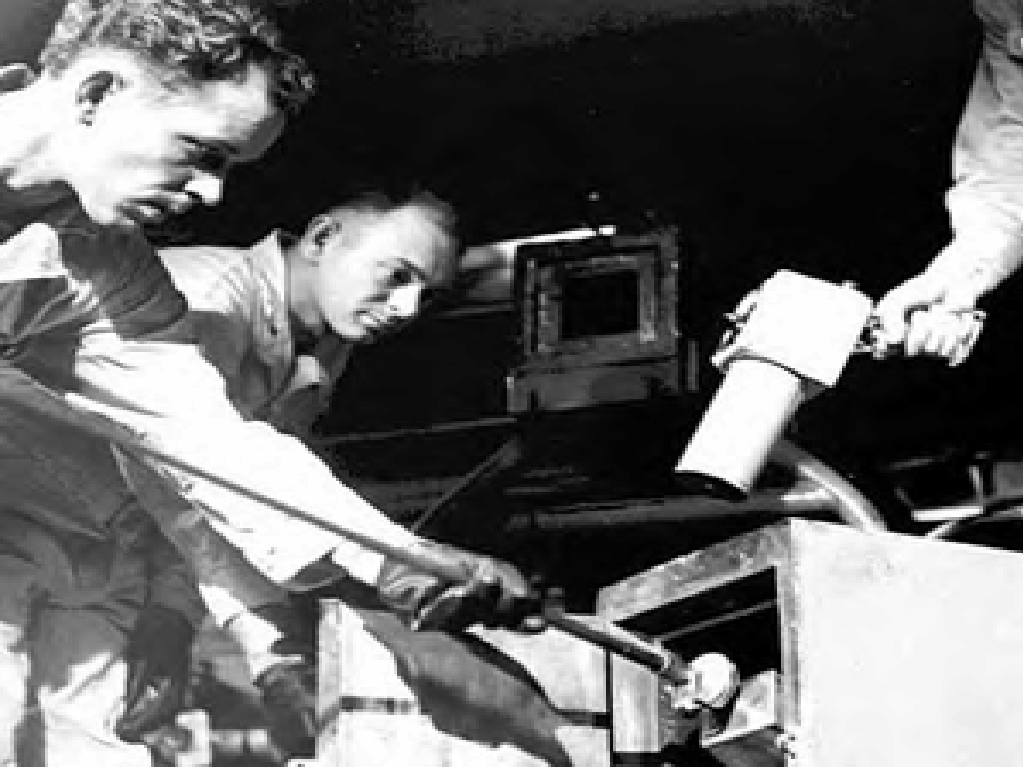
Cutie Pie at Oak Ridge

Cutie Pie CP-44 Ad 1950's
The Fish Pole Probe, introduced in 1945, was similar to the Cutie Pie except that the detector was on the end of a long pole. It was designed for much higher radiation readings of beta and gamma. It could measure from 5 R/h to 100 R/h. The calibration source was 2 g of radium.
The Fish Pole was similar to the Cutie Pie but the ion chamber was located at the end of a long pole. The probe could be extended 7 feet. It could measure up to 40 R/h. It measured 6 x 5.75 x 4.5 and weighed 5.5 lbs. The chamber was 3 diameter x 2.25 long.

Fish Pole Probe 1945
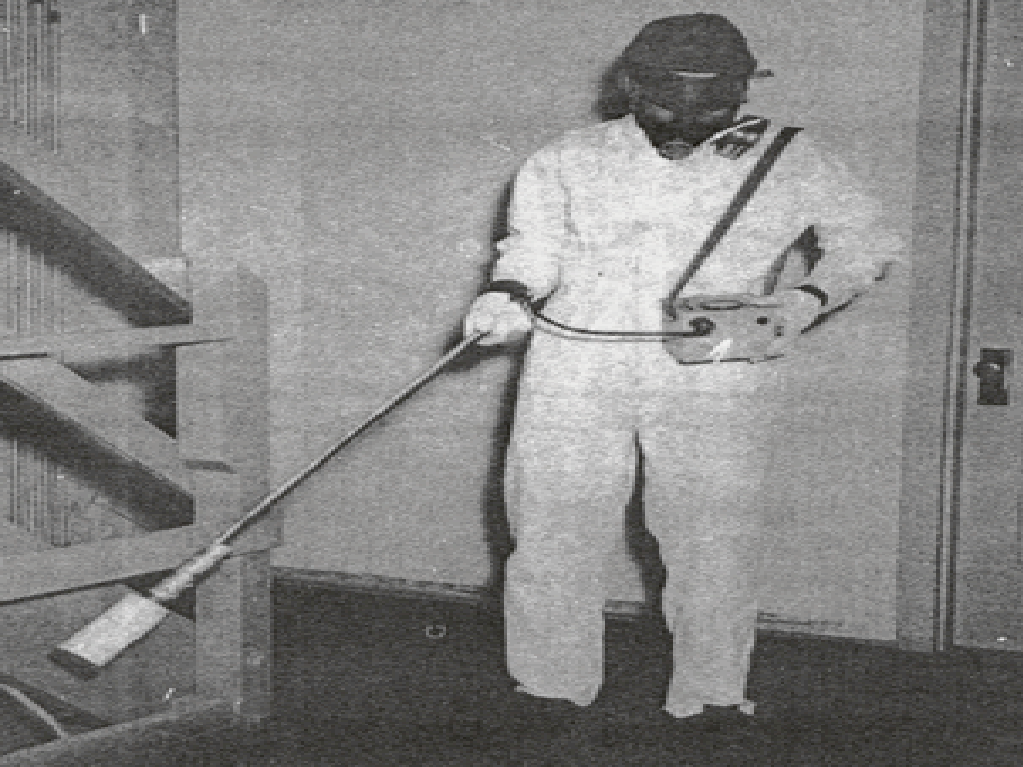
Fish Pole Probe 1948
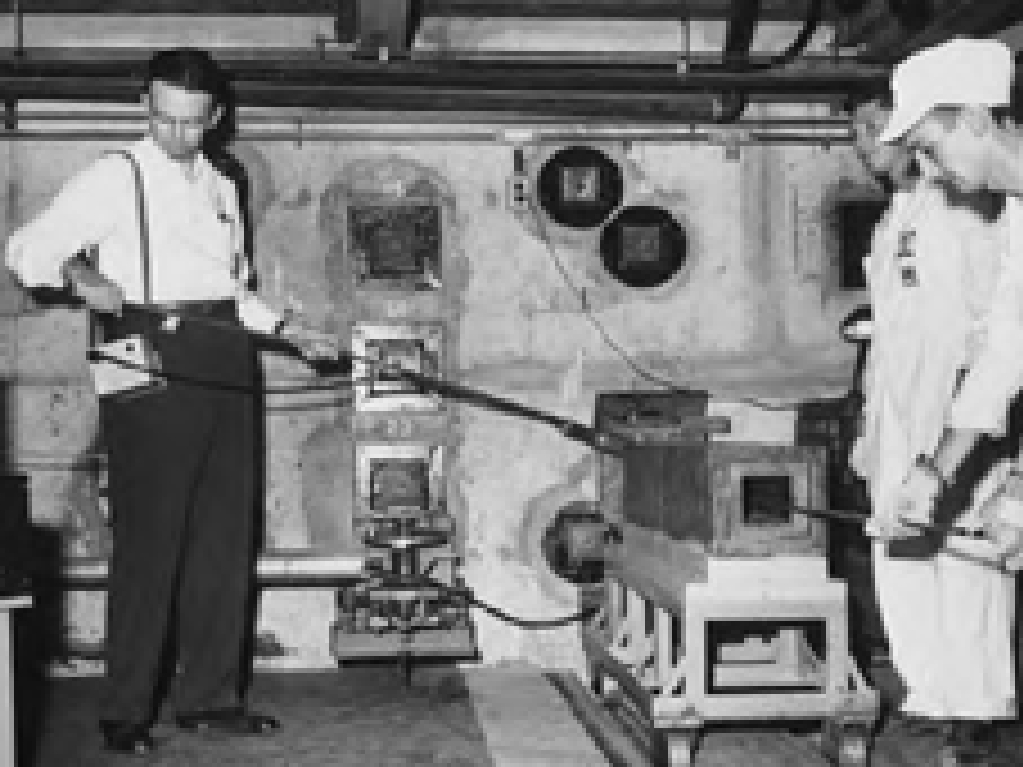
Fish Pole Probe
The 1952 High Range Fish Pole Probe could measure radiation between 5 R/h and 20-100 R/h.
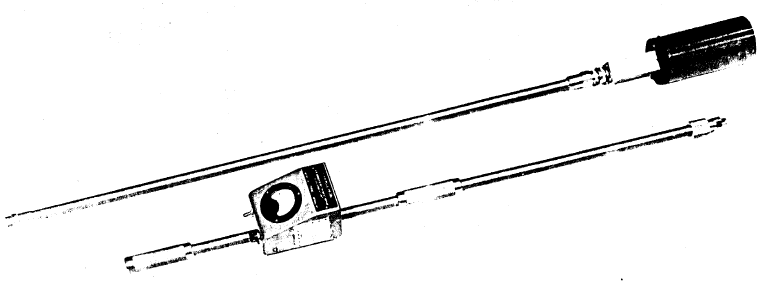
Fish Pole Probe 1952
The High Range Survey Meter, Fish Pole Probe was developed for detecting high levels of x-ray and gamma radiation. The ion chamber is located 60 inches from the meter and handle. The chamber was 3 diameter x 2.25 long. It could measure intensities up to 100 R/h. The control unit was 6 x 5.75 x 4.5 and weighed 5.5 lbs. The overall length was 7 long.
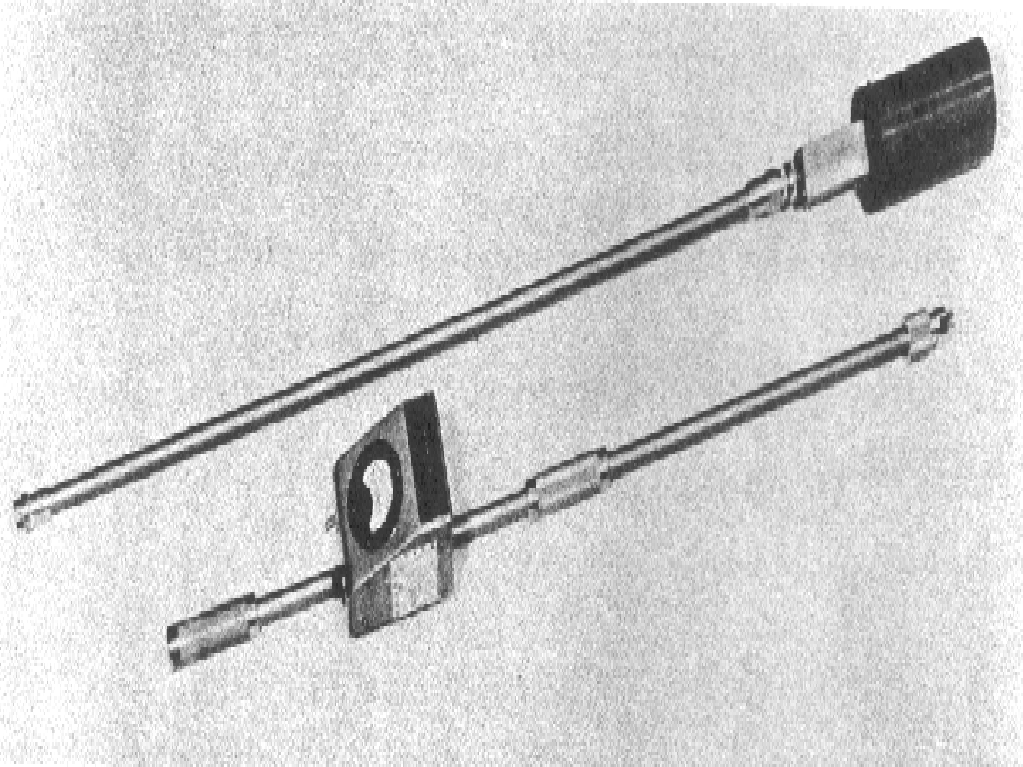
High Range Fish Pole Probe 1954
The Walkie-Talkie was a GM detector developed at the Clinton Engineering Works as early as March 1944 as a portable beta gamma detector. The unit got its name from from the fact that the operator wears headphones and carries the major part of the instrument from a shoulder strap. Early developed resulted in trial and error to eventually provide headphones for aural indications and the meter on the box housing strictly for monitoring the operating voltage of the GM tube. It had a glass wall GM tube in a 0.75 diameter x 6 external probe. The probe had a slide to discriminate against betas. The aluminum case measures 9-3/16 x 7 x 3-7/8 and weighed 10.5 lbs. It had three ranges from 0.2, 2 and 20 mR/h. The unit had no meter and used headphones as the indicator.
The unit's popularity was expanded by accommodating the use of a variety of probes. A submarine probe consists of a GM tube in a three-foot pipe and suspended in the water with a life preserver and towed behind a boat for lake or river surveying.
The unit could be equipped with a speaker and was designated as the Walkie-Squawkie. All early probes used the standard Eck and Krebs thin-walled glass counters with a three-foot cable. They were filled with 85% neon and 15% ethyl ether gas.
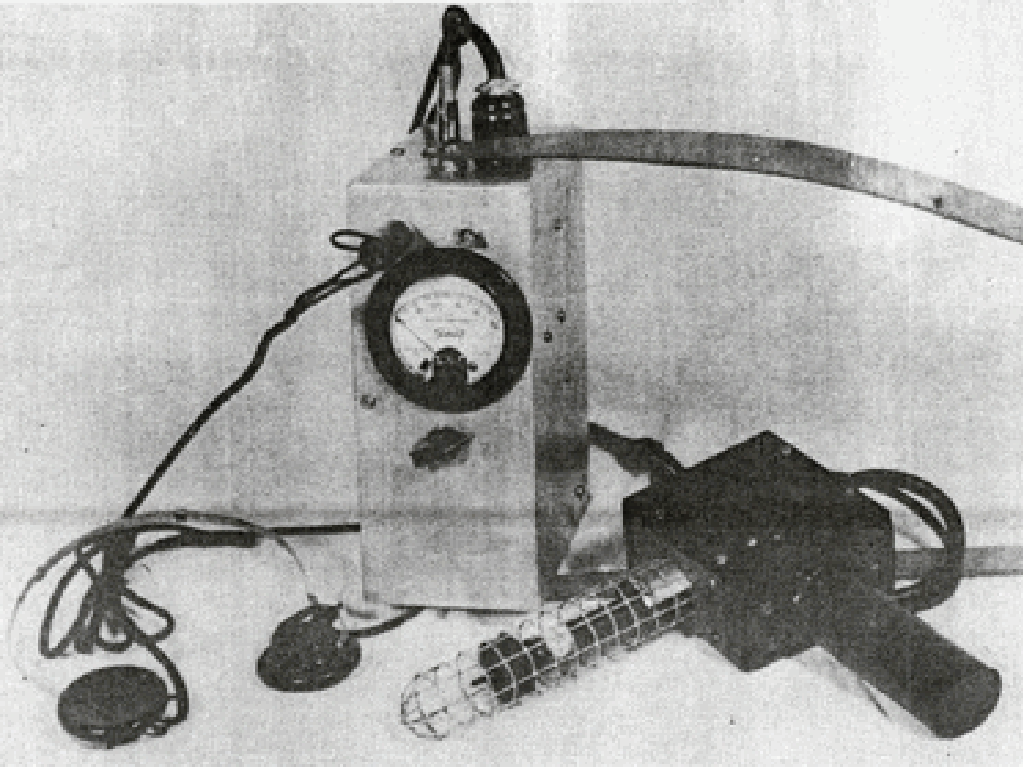

Oak Ridge Walkie-Talkie 1946
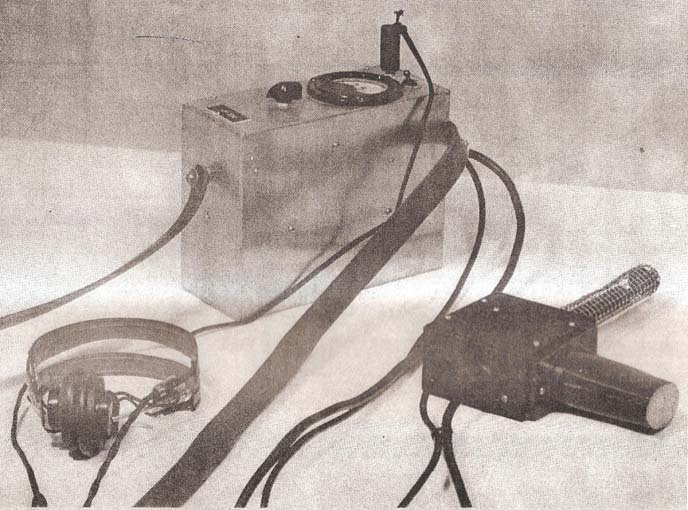
Oak Ridge Walkie-Talkie 1946
The Walkie-Squawkie was developed at the Clinton Laboratories Instrument Department as Model 482 in 1946. It measures beta and gamma radiation by an audio signal. It is the same as the Walkie-Talkie except that it has a loud speaker.
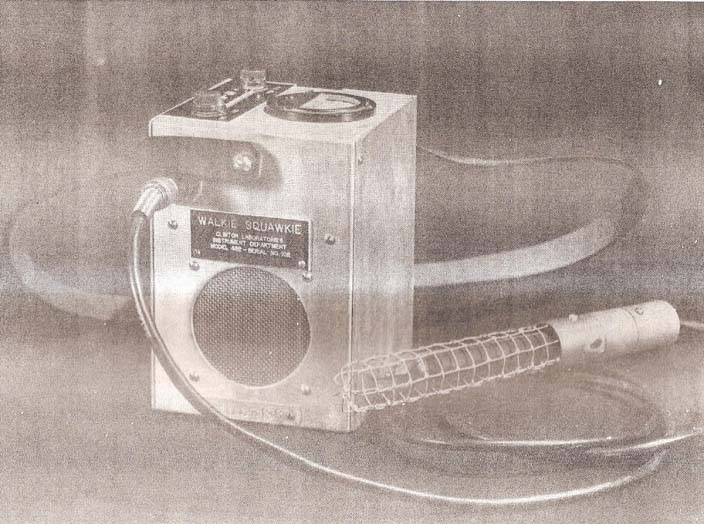
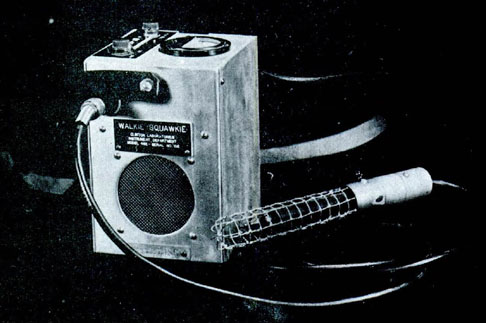
Walkie-Squawkie Model 482 1946
The Walkie-Poppie was developed in 1945 by R.A. Dandl as a portable, battery-powered proportional type alpha survey counter. It used audible indications for detection of alphas. It has a probe with an air proportional counter at atmospheric pressure. The unit is housed in a 3 x 10 x 10 aluminum case and weighs 9 lbs. The probes compact design makes it a very versatile instrument for health physics contamination surveys. The external probe has a Lucite pistol grip handle. The alpha chamber is an aluminum cylinder 3.2 cm diameter and 25 cm long. One side of the tube is milled to provide an opening for alpha detection. A thin nylon windows covers the opening.

Clinton Laboratories Walkie-Poppie 1945
The Walkie Poppy was modified in 1947. It was modified for both indoor and outdoor use in rain or shine. It was also capable of operating in 100% humidity. It used a probe-type air filled chamber with an aluminum wall and nylon window covered by a bronze screen.
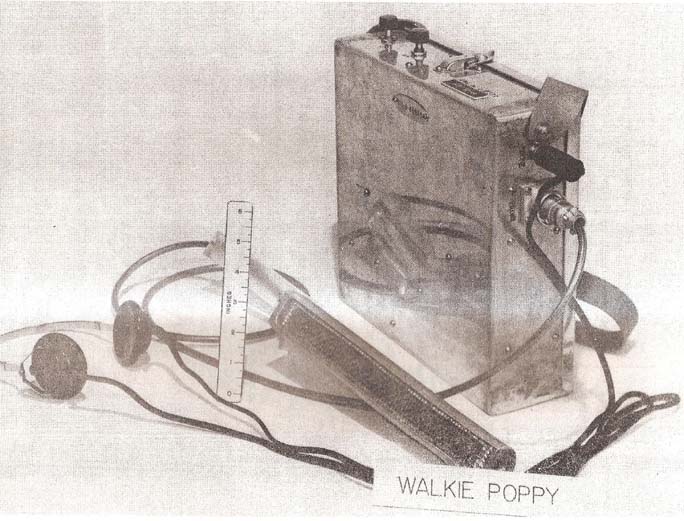
Walkie Poppy Model Q-327D 1947
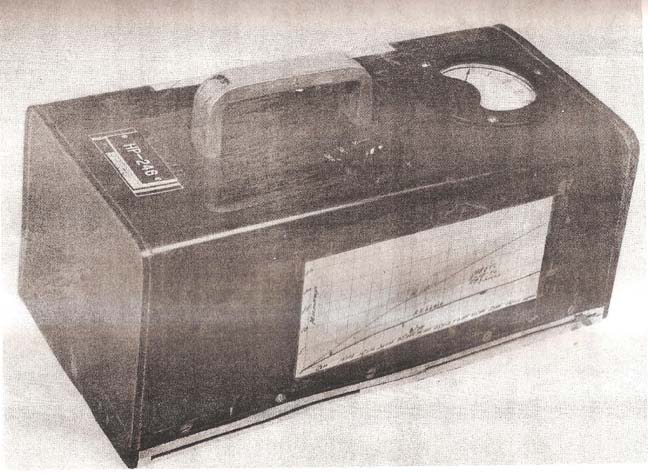
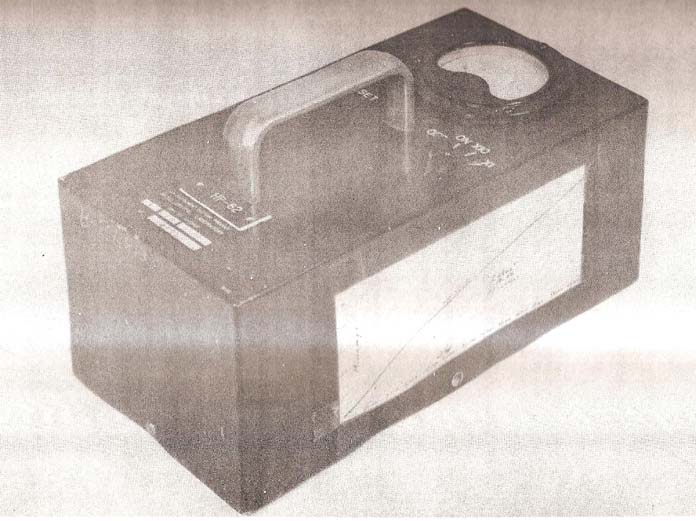
Clinton Laboratory Zeus (left) and Zeuto (right) 1949

Clinton Laboratory Beckman Survey Meter 1949
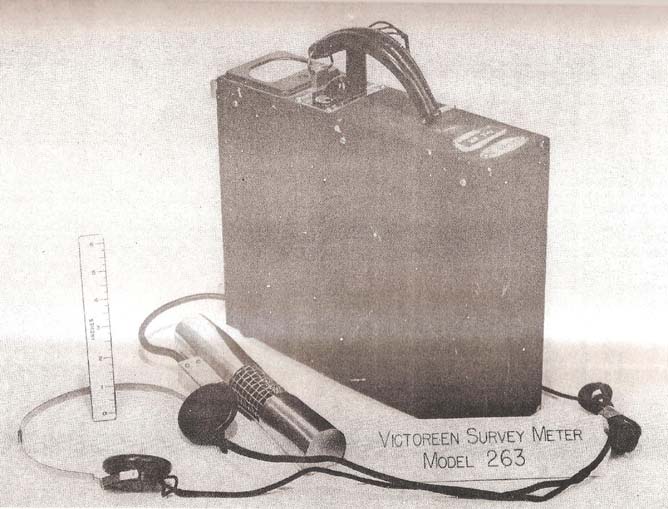
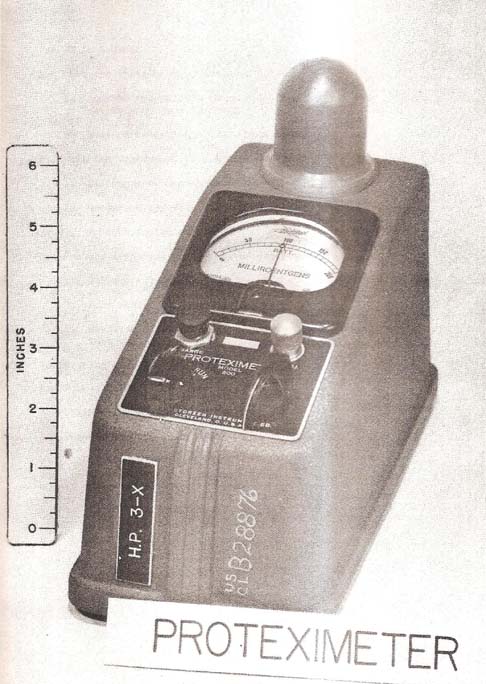
Clinton Laboratory Victoreen Model 263 (left) and Victoreen Proteximeter (right) 1949
Several general survey meters were used at Oak Ridge in 1952 and included models from Nuclear, El-Tronics, Tracer Lab and Precision Radiation Instruments.

Collage of General Use Survey Meters at Oak Ridge in 1952
The Pocket Radiation Alarm was developed by P.R. Bell in 1947. The ionization chamber is constructed of Lucite. The walls are made of conducting by a thin coating of colloidal graphite. A section of the wall is coated with boron for slow neutron detection. The unit is 1-3/8 x 2-1/4 x 5-3/4 and weighed 386 grams. It is designed to alarm on 50 mR.
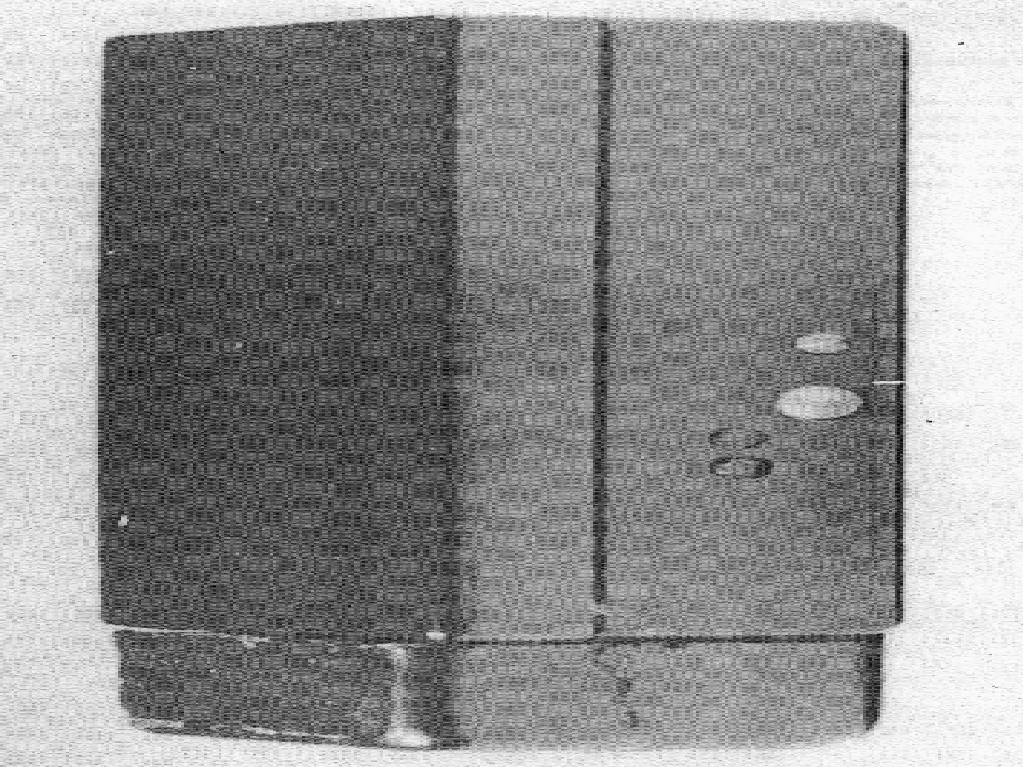
Pocket Radiation Alarm 1947
The AC Alpha Poppy was developed by H.M. Parker in 1945 and used at Oak Ridge as early as 1947 and later designated as in 1952 as designated Model 2801. It was designed to detect alphas with an air proportional counter probe. It had a range of 100, 1,000 and 10,000 cpm. The unit was 19.5 wide x 8.75 high and 14-7/8 deep and weighed 63 lbs. The chambers were 1.5 x 10. It had a speaker for indications which could be muted. The probe cable was 25 feet. The probe has a pistol grip handle with the counter extending on the end of the unit. The unit was not portable and powered by AC. The unit dates back to 1945 as being developed by C.J. Borkowski and C.R. Marsh.
The Cutie Pie and Zeus were the most frequently contaminated portable instruments. In 1949, D. Davis began processing instruments with a peelable plastic coating for ease in decontamination.
The Poppy pulse type detector for alpha, beta, gamma and neutrons was developed in 1945 b y C.J. Borkowski and C.R. Marsh. The unit operated on 110 volts AC. The alpha probe is a proportional counter and operates in air at atmospheric pressure. Each alpha detected produces a pop sound in the loud speaker. It uses external survey probes. The probes are readily interchangeable and come in various sizes and shapes. The unit has three ranges of 200, 2,000 and 20,000 pulses per minute. The unit was housed in a wooden cart with wheels for ease of movement.
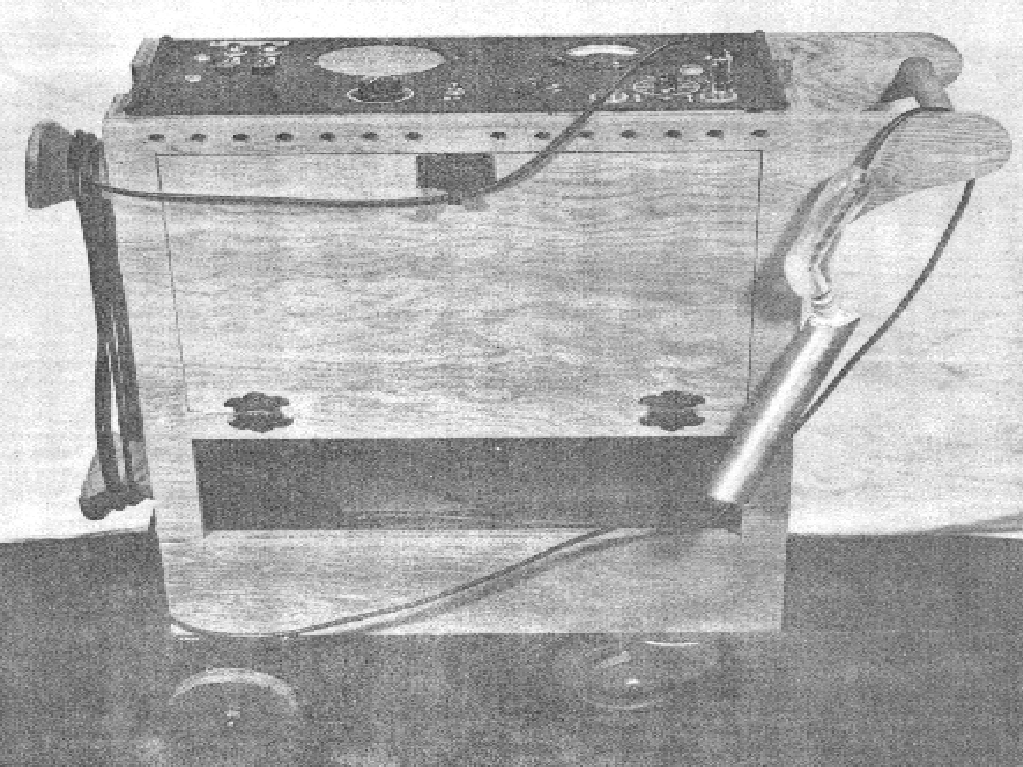
Clinton Labs AC Poppy 1945
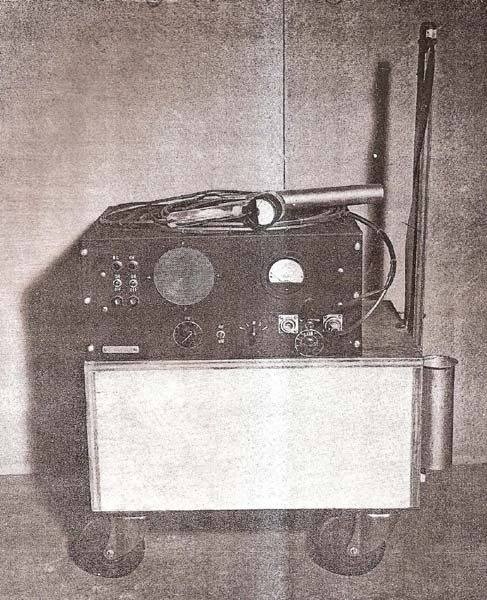
Clinton Labs AC Poppy 1945
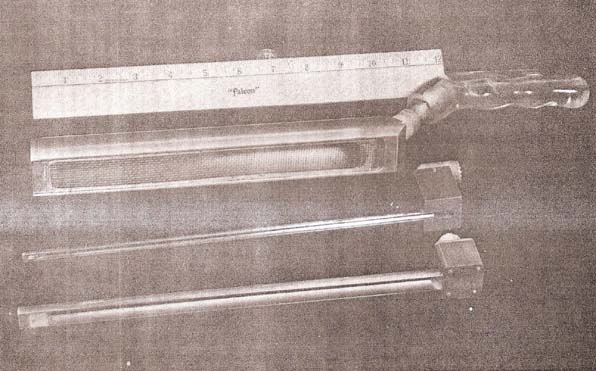
Clinton Labs AC Poppy Alpha Probes 1945
The Ό probe is useful for detecting contamination in test tubes and centrifuge cones. For routine surface contamination surveys, the 1-1/2 probe can be used. A GM counter can be used for beta and gamma detection. The counter is filled to one atmosphere with methane. It has a thin aluminum window for beta detection. Slow neutron detection is with a boron coated cylindrical chamber 1-1/2 diameter by 10 long. Fast neutron can be detected with the same probe with a cadmium can over the probe, with the inside lined with one inch paraffin or polyethylene.
The portable alpha poppy was developed at Oak Ridge in 1953. It consisted of two unit, the control unit with batteries and the alpha probe. Detection was by headphones. It employs a proportional counter. It uses one 1.5, one 3, one 45 and one 300 volt batteries. The unit weighs 6 lbs.
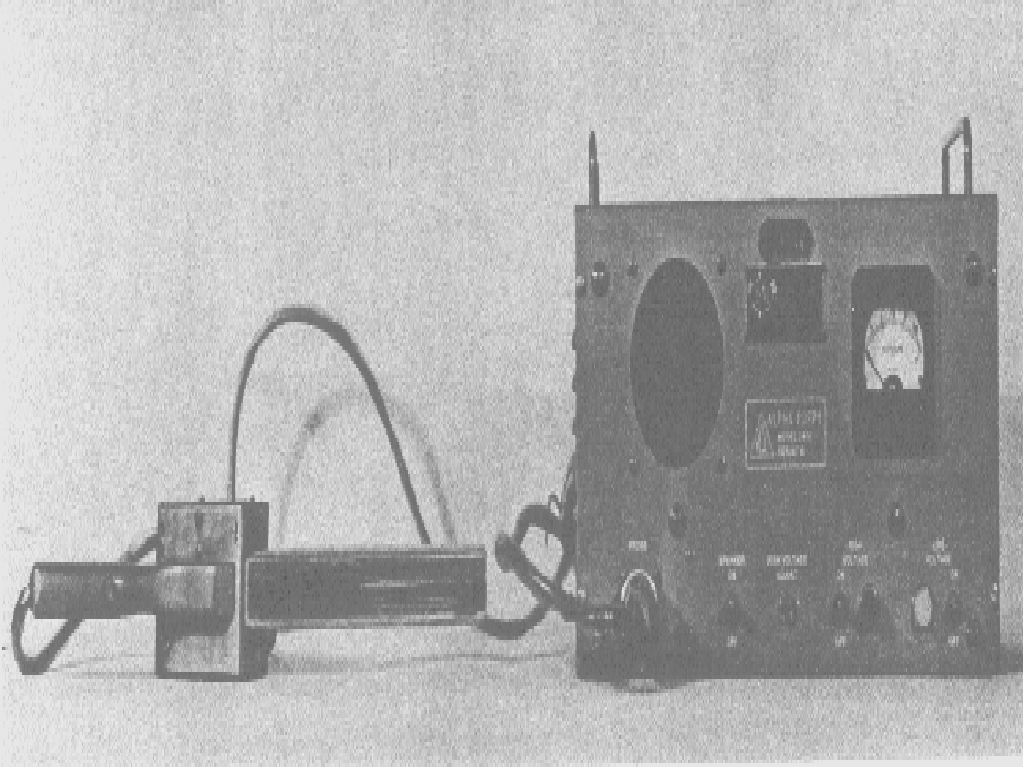
Oak Ridge AC Alpha Poppy 1952
Oak Ridge developed an alpha scintillation probe which was AC operated in 1958. The probe contained a ZnS phosphor and a photomultiplier. The sensitive diameter of the phosphor depends on the size of the photomultiplier. A 2 photomultiplier gives 2-5 inches sensitive area. A 5 phototube can be used with a 5 phosphor.
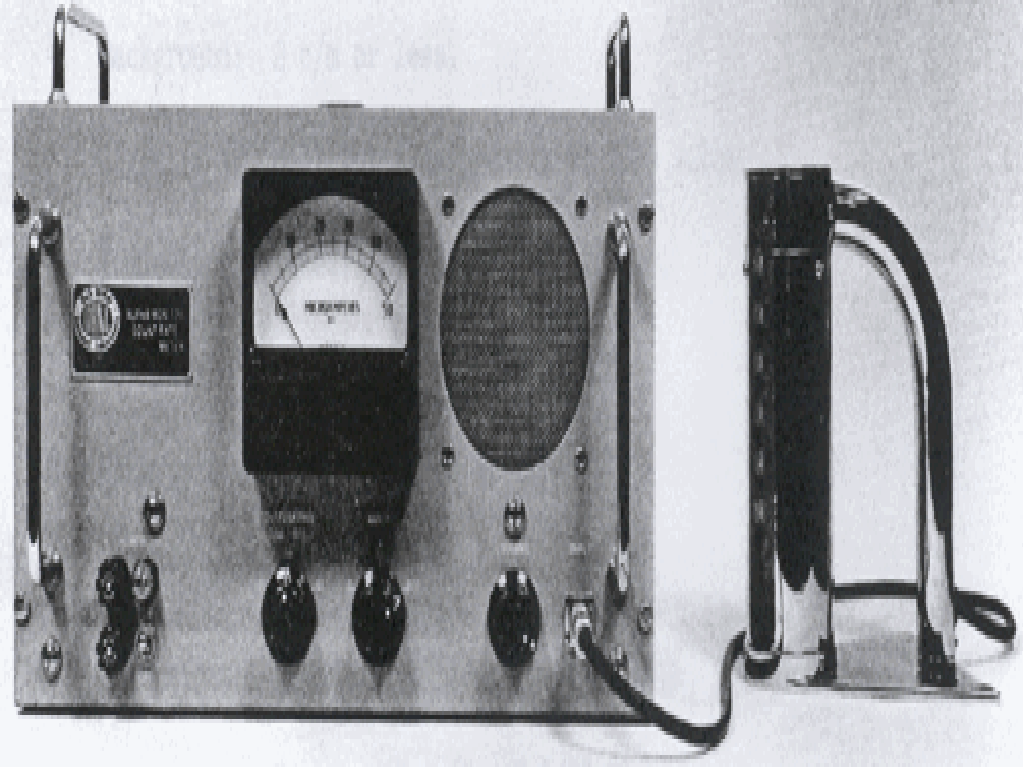
Oak Ridge AC Alpha Poppy 1958
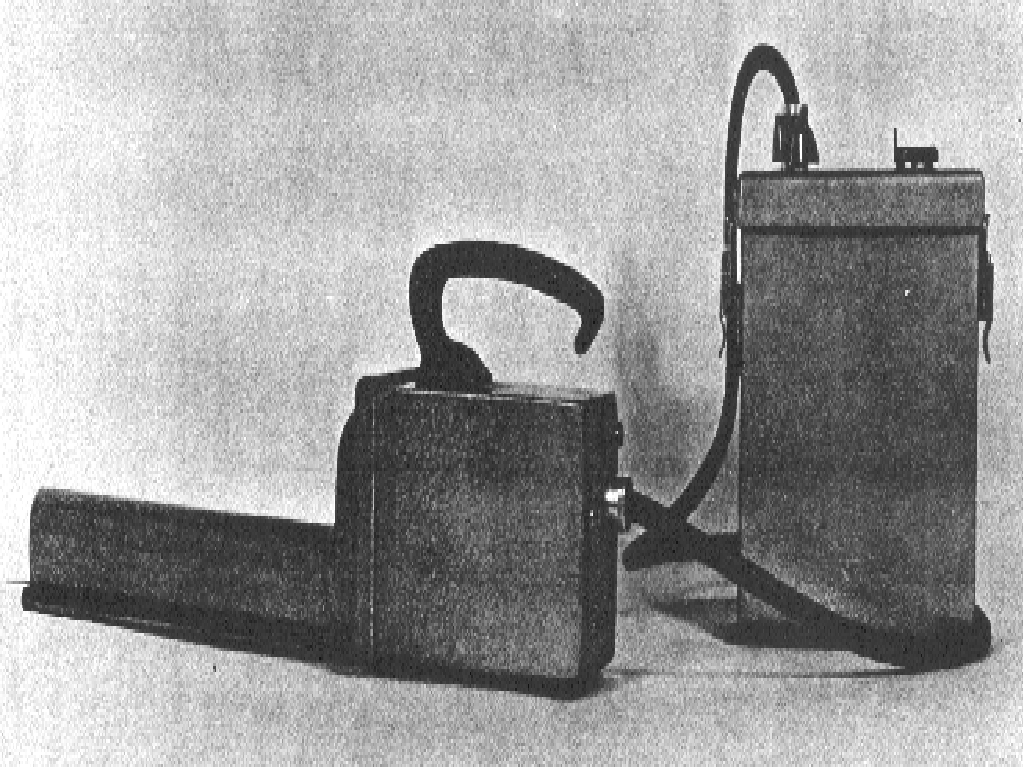
Portable Alpha Poppy 1954
The Oak Ridge alpha scintillation counter was developed in 1959. The unit used a Ni-Cd battery which was kept charged by a trickle charger at 110 volts. The probe has a ZnS phosphor coupled to a photomultiplier tube. The phosphor was about 2.5 diameter. The control unit is 6 long, 5.5 high x 5 wide and weighs 4 lbs. The probe is 6 x 6 x 7.5 high.
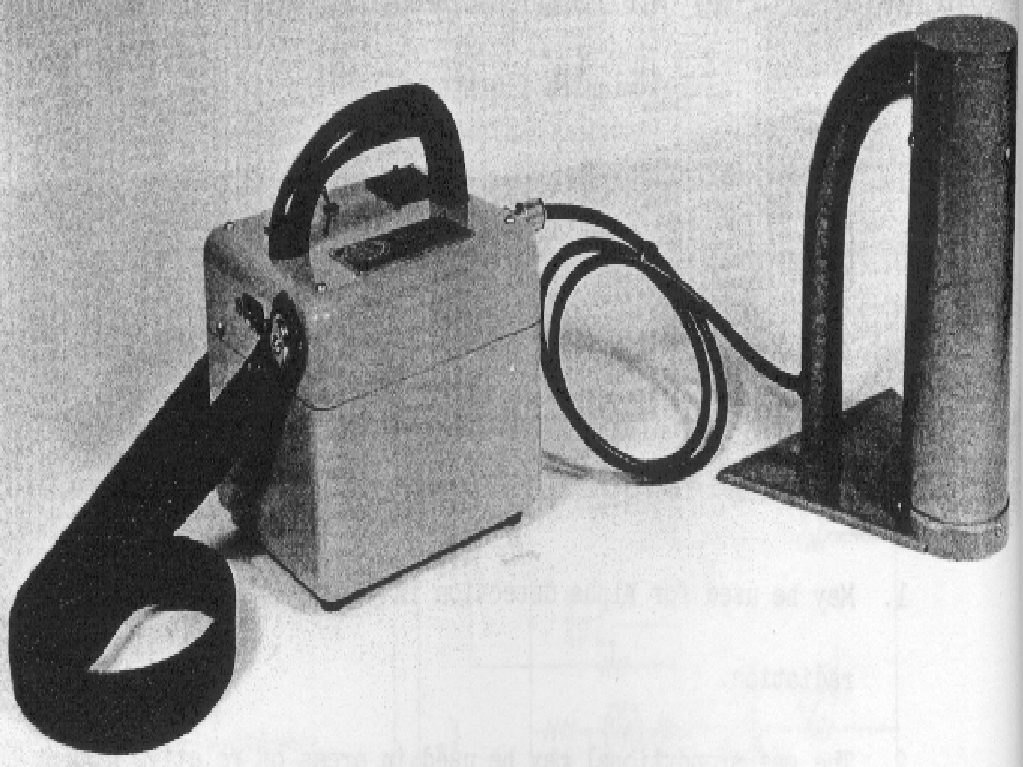
Oak Ridge Alpha Poppy 1959
The Eberline Model PAC-30 was used at Oak Ridge in 195x. Two types of proportional counters were used. One was an air chamber and the other a propane gas-flow chamber. The unit read full scale of 1000 cpm with three ranges of X1, X10 and X100 range settings. The air chamber was 8.25 x 4 wide x 6 long and the gas flow chamber was 8.25 x 4 wide x 9.75 long. The air flow unit weighed 7.5 lbs and the gas flow 9 lbs.
Need photo
Eberline Model PAC-30 195x
A gamma scintillation counter was developed in the 1954 at Oak Ridge. It was portable with a either a 1x1 or 2x2 NaI crystal and photomultiplier. It read in cpm which could be converted to doses from 0.001 mR/h to 5 mR/h. It came with two time constants. The high voltage was fixed at 900 or 1200 volts. The unit was 10-12 long x 3-5 wide x 6-8 high and weighed 6-12 lbs.
The Juno survey meter was used as early at 1951 at Oak Ridge. It was developed for the AEC by Espey Manufacturing. It had a meter in microamperes and a conversion chart for mR/h. It had ranges of x1, x10 and x100. It was 10 x 5.5 x 6.5 and weighed 4.5 lbs. The gamma range was 50, 500 and 5000 mR/h. The alpha range was 10K, 100K and 1000K dpm. It had three aluminum absorbers which were retractable by a slide on the lucite handle.
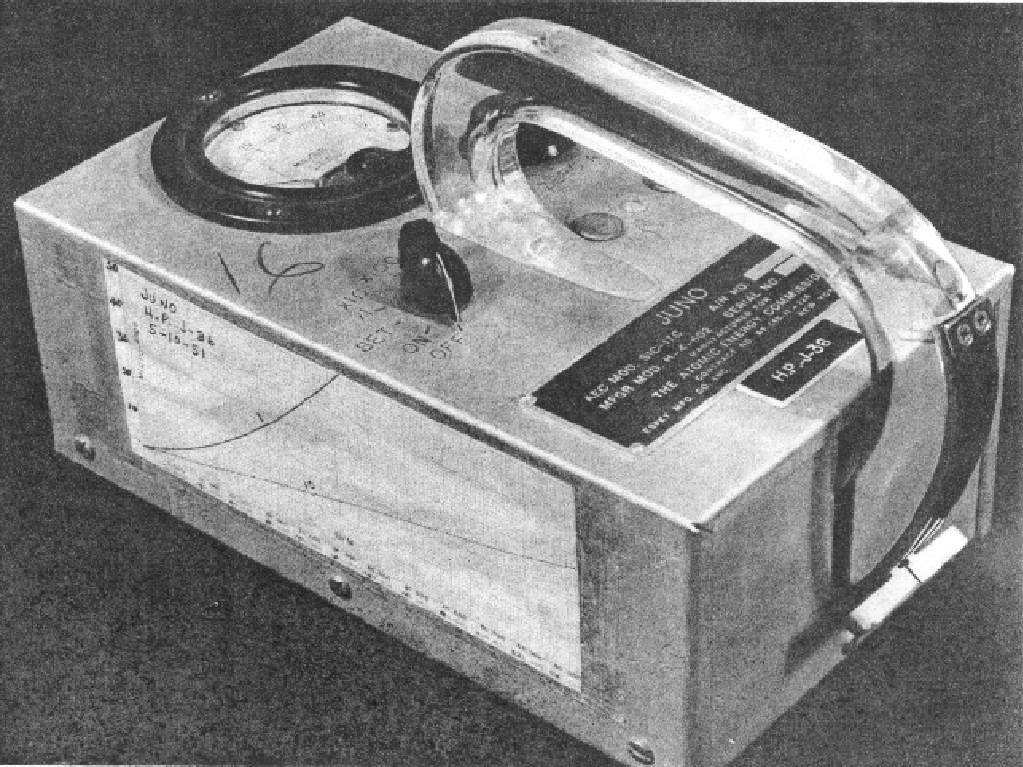
Espey Juno Model H-4-602 1951
The Long Tom Cutie Pie is a modified Cutie Pie. The meter and ion chamber are separate on a pole which is 40 long. The ion chamber is smaller than the Cutie Pie and gives only one half the sensitivity.
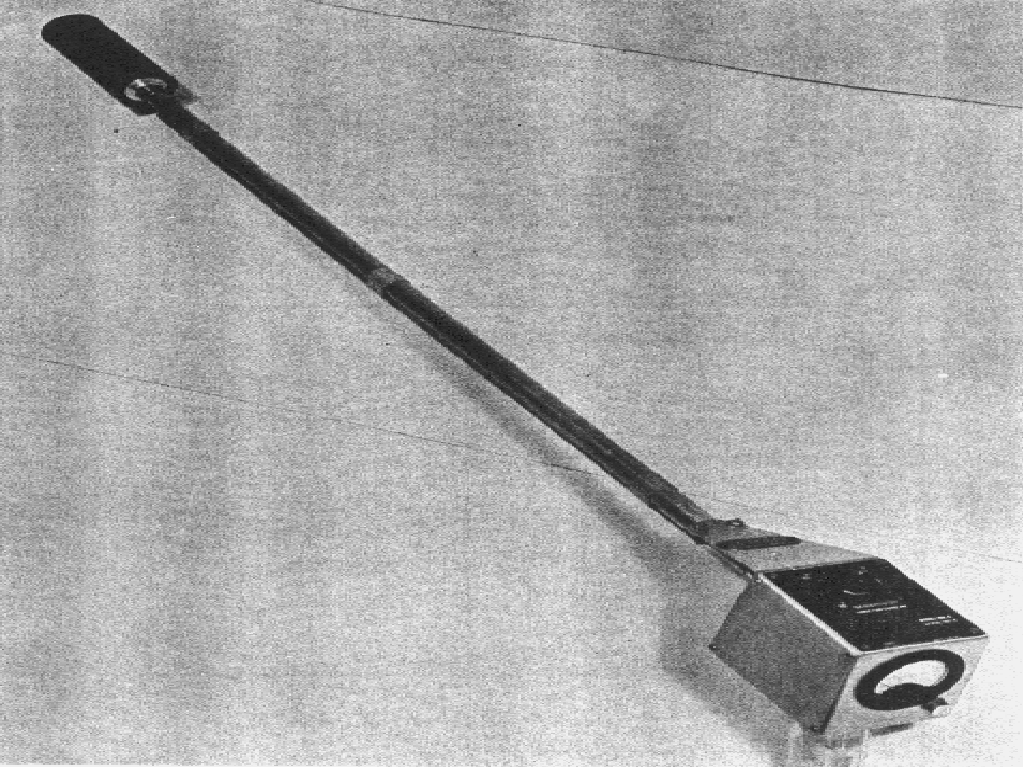
Oak Ridge Long Tom Cutie Pie 1953
Stafford L. Warren a radiologist and medical educator and Professor of Radiology at the University of Rochester School of Medicine. In March 1943, he became an advisor to the Manhattan Engineer District. Later that year he was commissioned a Colonel in the Army Medical Corps and appointed Chief Medical Advisor to the commanding general. Later he, was the chief of the medical section at Oak Ridge. He was the radiological advisor for Operation Crossroads, the Trinity tests? And the first Bikini Island atomic tests.
William F. Bale was a physicist and head of the Division of Radioactivity at the University of Rochester. He developed a portable 40 lb battery operated Geiger counter in June 1943.
The Paint Pail was an ion chamber for gamma detection in a paint can developed by Ray at the Clinton Laboratories in 1944. It could measure 20, 200 and 2,000 mR/h. The large ionization chamber was 9 long x 9 diameter. The entire unit was 9 x 20 with a pistol grip and weighed 10-7/8 lbs. W.P. Overbeck developed the paint pail in 1943.
Need photo
Paint Pail Ion Chamber 1943
It should be noted that Hallicrafters Company was contracted in 1944 to produce 75 instruments for beta gamma measurements with a range of 0.001 R/8-hr. The company was still in operation in 1955.
The Feinberg Radiation Meter was a beta gamma ion chamber detector available as early as 1945. It could measure 25, 100 and 1000 mR/h. It was 10 x 6.5 x 11.5 and weighed 11.5 lbs. The chamber was 6 x 6.
Need photo
Feinberg Radiation Meter 1945
The Chang and Eng was named after the famous Siamese twins because it had two compensated ion chambers. One of the chambers was lined with boron. The chambers were 3.5 diameter x 6 long. It was 15 x 5 x 15 and weighed 80 lbs.
An air monitor was developed named Sneezy in 1944 along with an air sampler named Filter Queen.

Chang and Eng Early 1940s
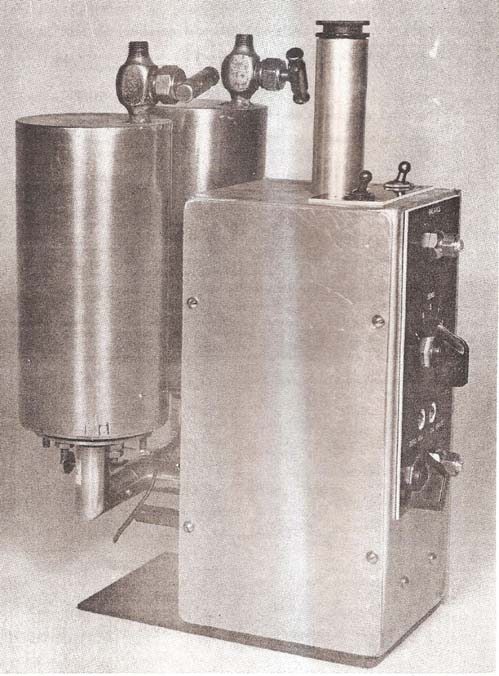
Oak Ridge Chang and Eng 1947
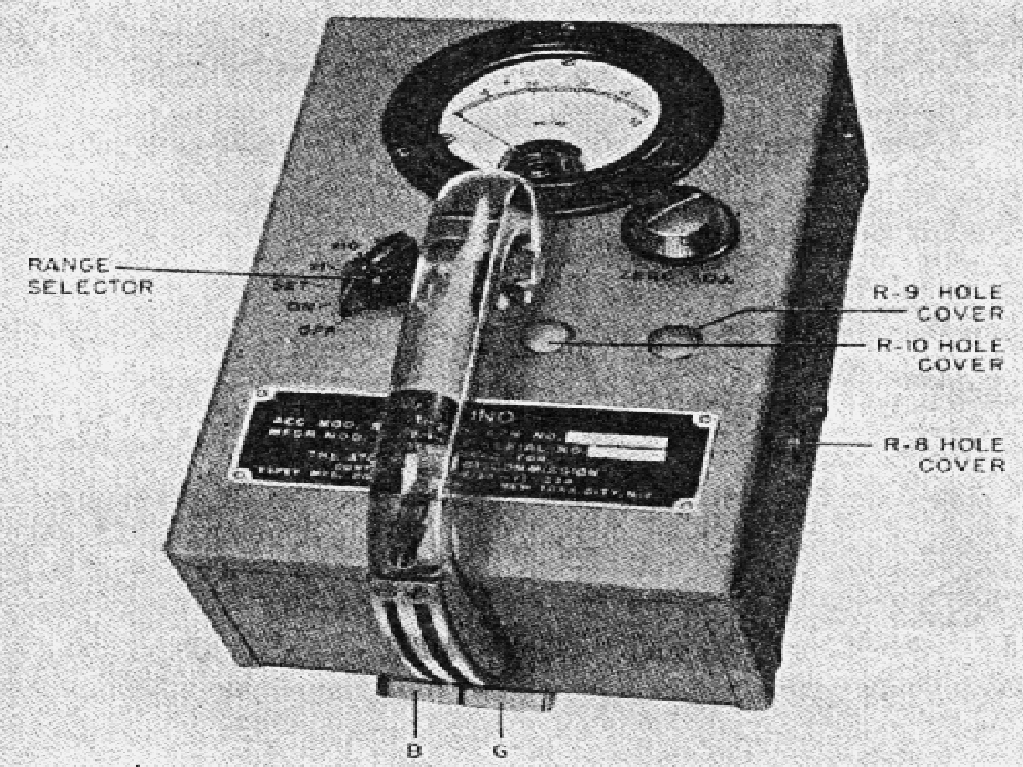
Espey Juno 1951

Oak Ridge Cutie Pie 1954
Oak Ridge required fast neutron detectors to support the nuclear reactor operations at X-10. The portable fast neutron detector could detect neutrons from 0.1 to 10 MeV with ranges from 10 to 10,000 neutrons/cm2/second. The proportional counter cylinder has dimensions of 2.5 cm x 7 cm long.
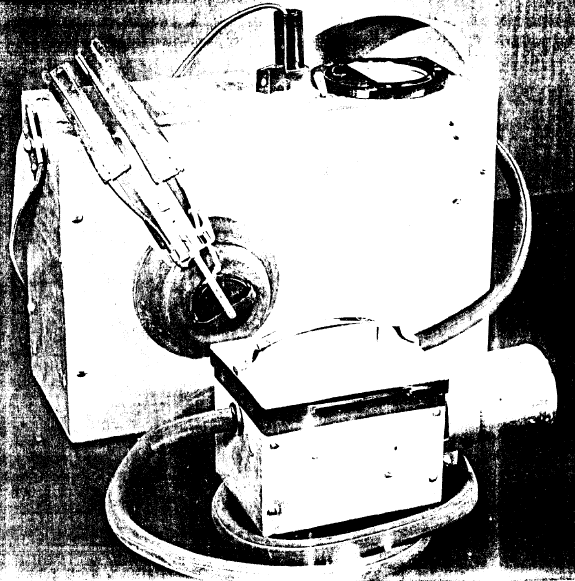
Portable Fast Neutron Meter 1952
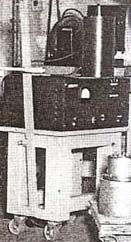
Monitron Area Monitor 1950
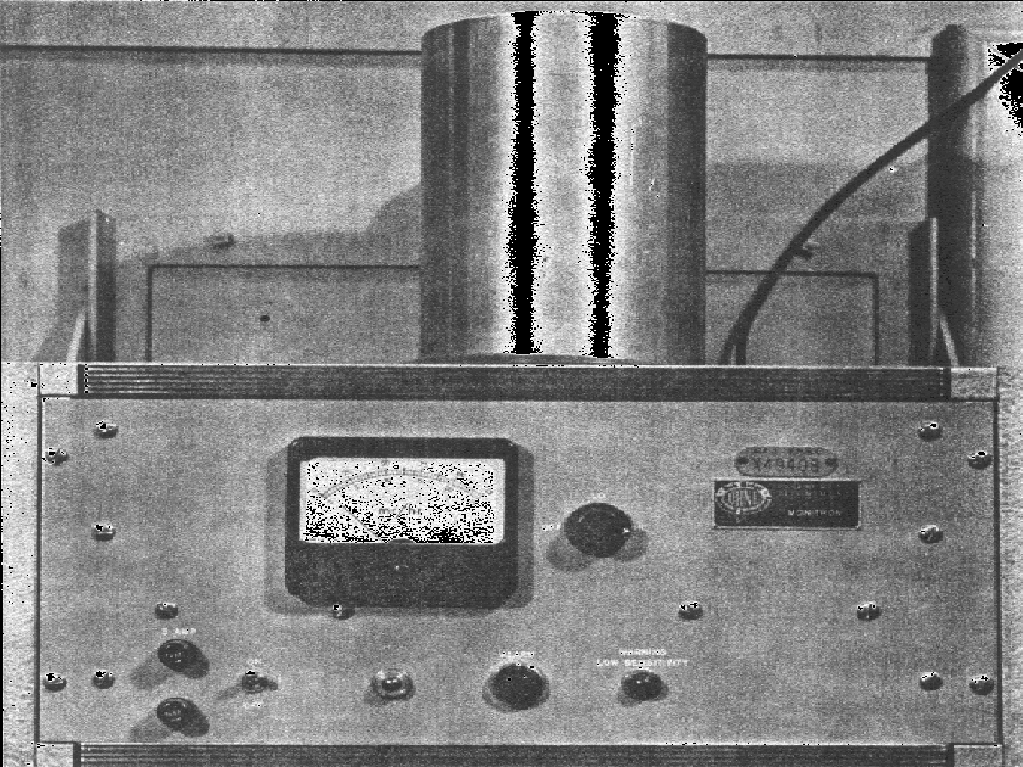
Oak Ridge Neutron Monitron 1954
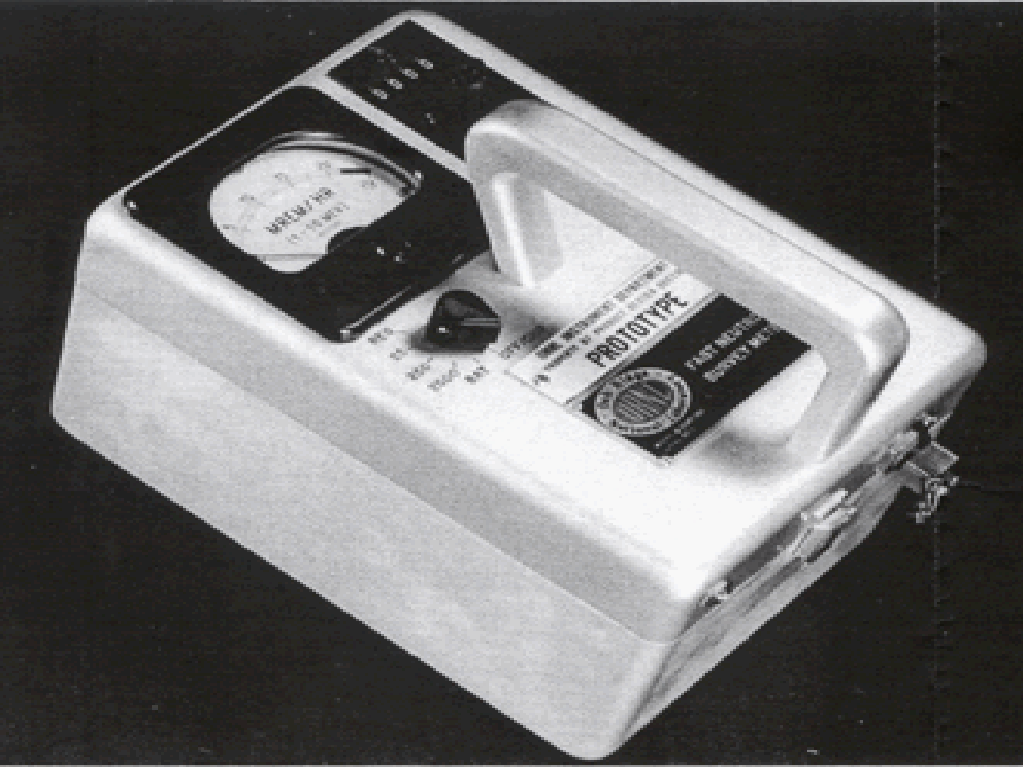
Oak Ridge Fast Neutron Counter 1959
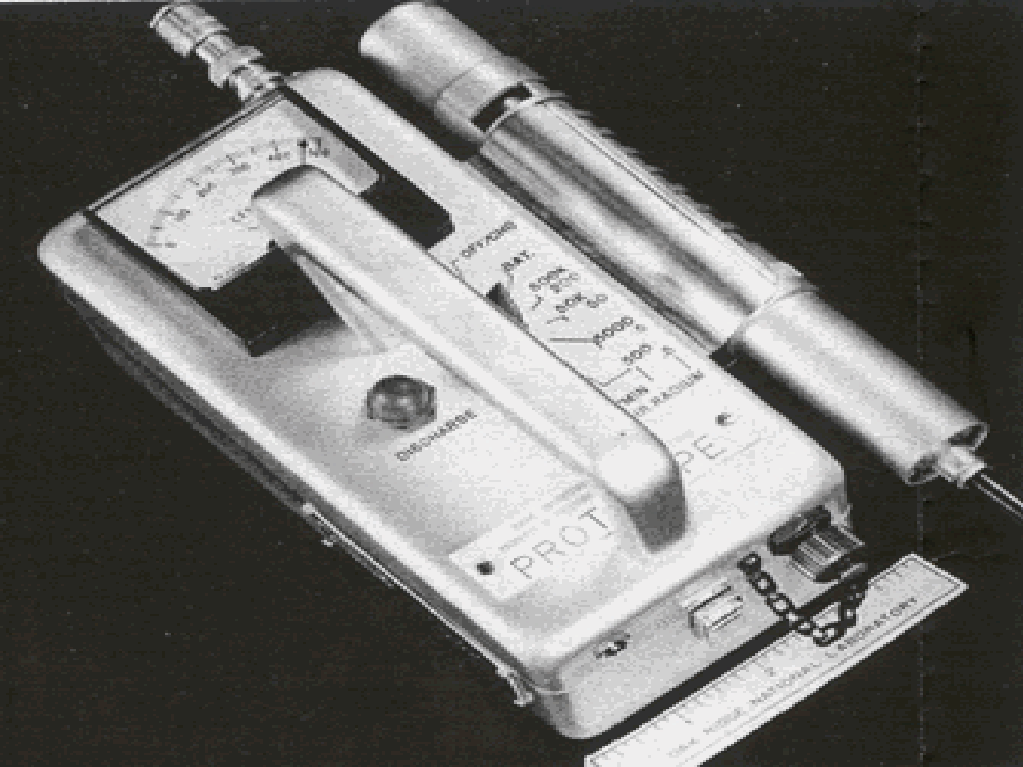
Oak Ridge GM Survey Meter 1960
The Oak Ridge gamma scintillation counter was developed in 1954 and contains a sodium iodide crystal and photomultiplier. The unit measured from 0.001 mR/h to 5 mR/h. The NaI detector was 1x1 or 2x2. The probe was 10-12 long x 3-5 wide x 6-8 high and weighed from 6-12 lbs.
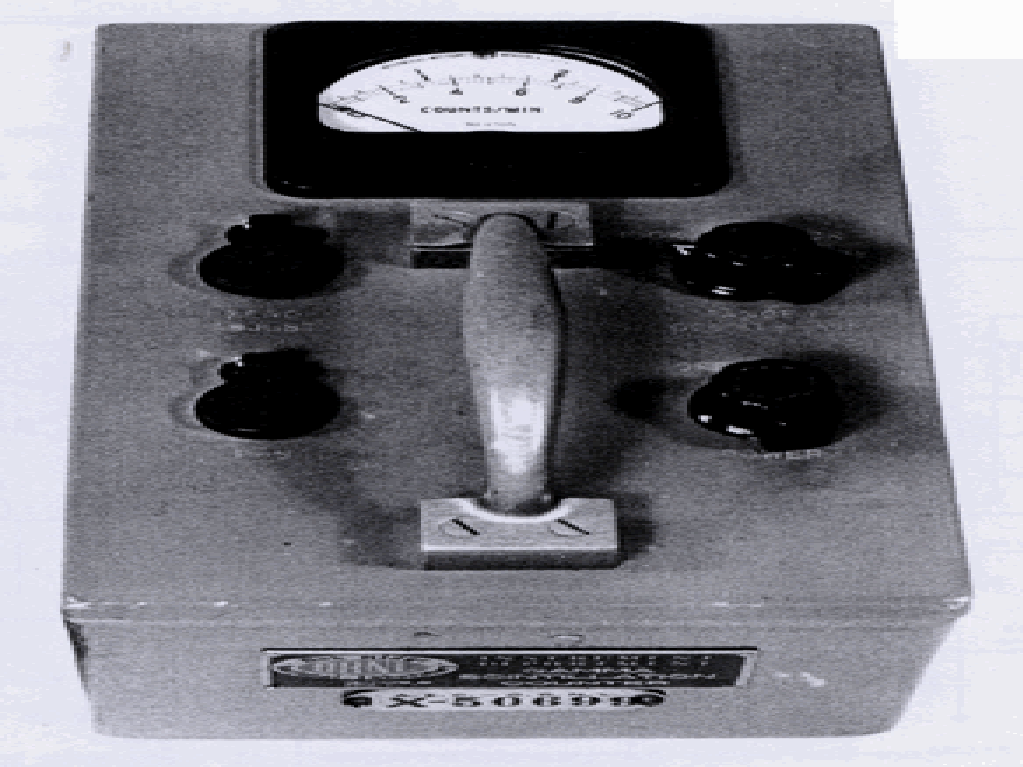
Oak Ridge Scintillation Counter 1954
The Precipitron was developed as early as 1944 for measuring airborne alpha contamination. A similar instrument was called the Sneezy.

Oak Ridge Precipitron 1954
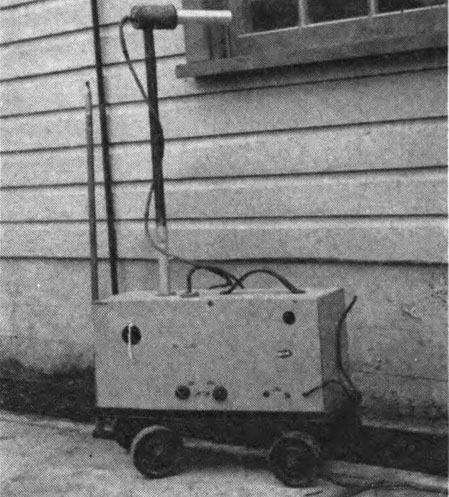
Oak Ridge Precipitron to Measure Airborne Contamination around a Building 1950
The Thermal Neutron Counter was developed at Oak Ridge in 1960. It is fully transistorized and used rechargeable nickel-cadmium cells. The unit had three ranges from 1K, 5K and 20K. The detector was BF3, low pressure filled chamber. The unit measures 8 x 5.5 x 5 and weighs 4 lbs. The chamber was 6 x 0.5.
Need photo
Thermal Neutron Survey Meter 1960
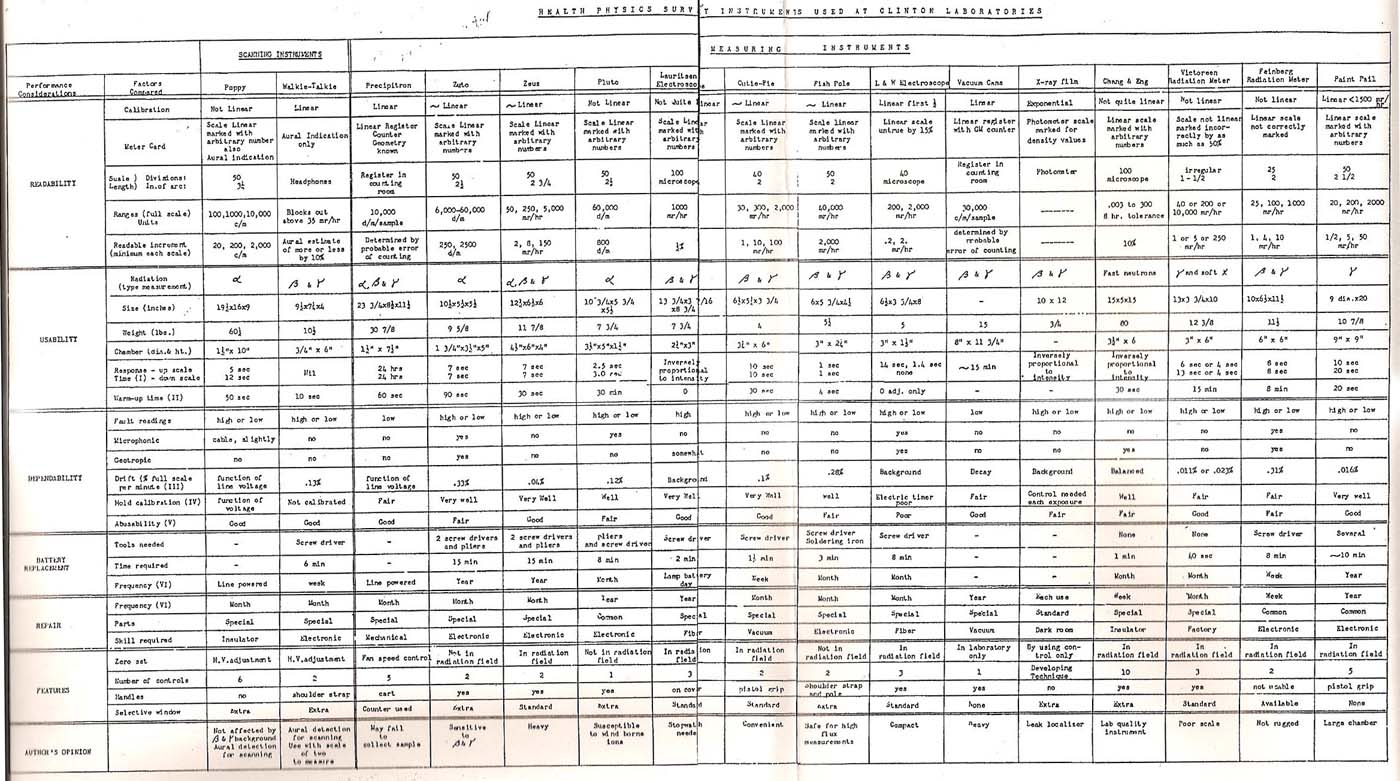
Clinton Radiation Detectors Chart from 1946

Clinton Radiation Detectors Chart from 1951